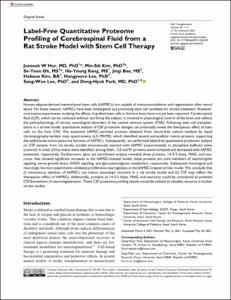Label-Free Quantitative Proteome Profiling of Cerebrospinal Fluid from a Rat Stroke Model with Stem Cell Therapy
- Title
- Label-Free Quantitative Proteome Profiling of Cerebrospinal Fluid from a Rat Stroke Model with Stem Cell Therapy
- Author(s)
- Hur, Junseok W. ; Kim, Min-Sik ; Oh, Se-Yeon ; Kang, Ho-Young ; Bae, Jingi ; Kim, Hokeun ; Lee, Hangyeore ; Lee, Sang-Won ; Park, Dong-Hyuk
- Issued Date
- 2021-06
- Citation
- Cell Transplantation, v.30
- Type
- Article
- Keywords
- MYELIN-ASSOCIATED GLYCOPROTEIN ; LIQUID-CHROMATOGRAPHY SYSTEM ; MARROW STROMAL CELLS ; ASTROCYTES ; EXPRESSION ; IDENTIFICATION ; NEUROCAN ; INJURY ; BRAIN
- ISSN
- 0963-6897
- Abstract
- Human adipose-derived mesenchymal stem cells (hAMSCs) are capable of immunomodulation and regeneration after neural injury. For these reasons, hAMSCs have been investigated as a promising stem cell candidate for stroke treatment. However, noninvasive experiments studying the effects of grafted stem cells in the host brain have not yet been reported. Cerebrospinal fluid (CSF), which can be collected without sacrificing the subject, is involved in physiological control of the brain and reflects the pathophysiology of various neurological disorders of the central nervous system (CNS). Following stem cell transplantation in a stroke model, quantitative analysis of CSF proteome changes can potentially reveal the therapeutic effect of stem cells on the host CNS. We examined hAMSC-secreted proteins obtained from serum-free culture medium by liquid chromatography-tandem mass spectrometry (LC-MS/MS), which identified several extracellular matrix proteins, supporting the well-known active paracrine function of hAMSCs. Subsequently, we performed label-free quantitative proteomic analysis on CSF samples from rat stroke models intravenously injected with hAMSC (experimental) or phosphate buffered saline (control). In total, 524 proteins were identified; among them, 125 and 91 proteins were increased and decreased with hAMSC treatment, respectively. Furthermore, gene set enrichment analysis revealed three proteins, 14-3-3 theta, MAG, and neurocan, that showed significant increases in the hAMSC-treated model; these proteins are core members of neurotrophin signaling, nerve growth factor (NGF) signaling, and glycosaminoglycan metabolism, respectively. Subsequent histological and neurologic function experiments validated proliferative neurogenesis in the hAMSC-treated stroke model. We conclude that (i) intravenous injection of hAMSCs can induce neurologic recovery in a rat stroke model and (ii) CSF may reflect the therapeutic effect of hAMSCs. Additionally, proteins as 14-3-3 theta, MAG, and neurocan could be considered as potential CSF biomarkers of neuroregeneration. These CSF proteome profiling results would be utilized as valuable resource in further stroke studies.
- Publisher
- SAGE Publications Ltd
- Related Researcher
-
-
Kim, Min-Sik
- Research Interests Cancer Proteogenomics; Biomarker Discovery; Integrative Multi-Omics
-
- Files in This Item:
-
 기타 데이터 / 960.4 kB / Adobe PDF
download
기타 데이터 / 960.4 kB / Adobe PDF
download
- Appears in Collections:
- Department of New Biology Laboratory for QBIO and Precision Medicine 1. Journal Articles



